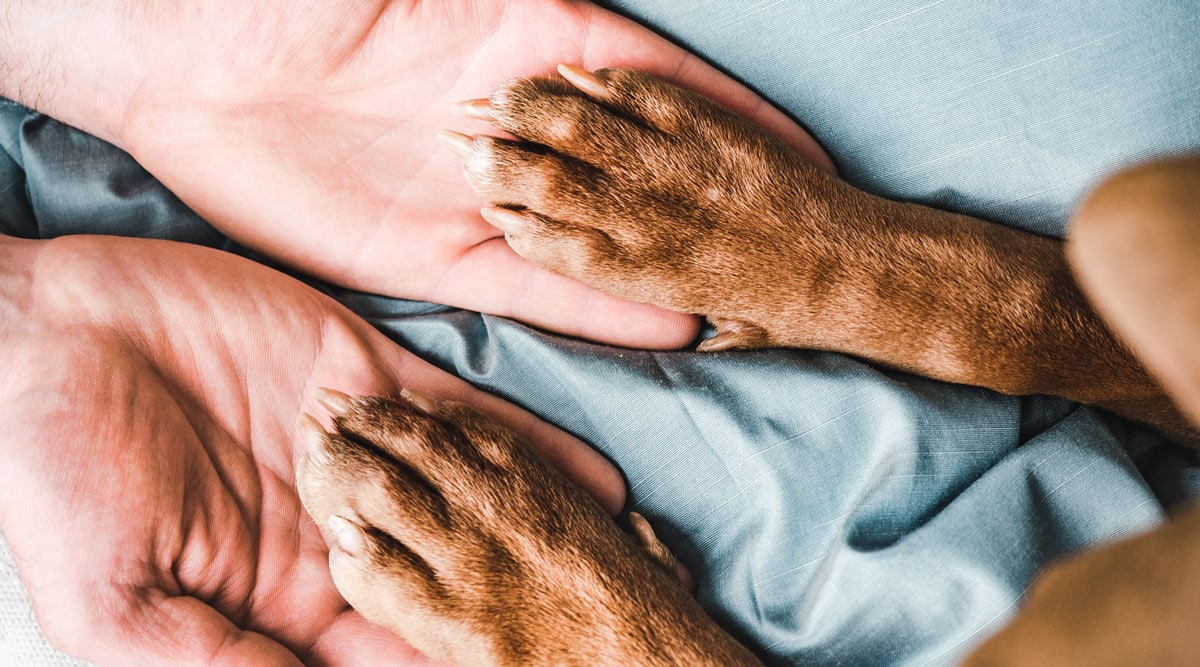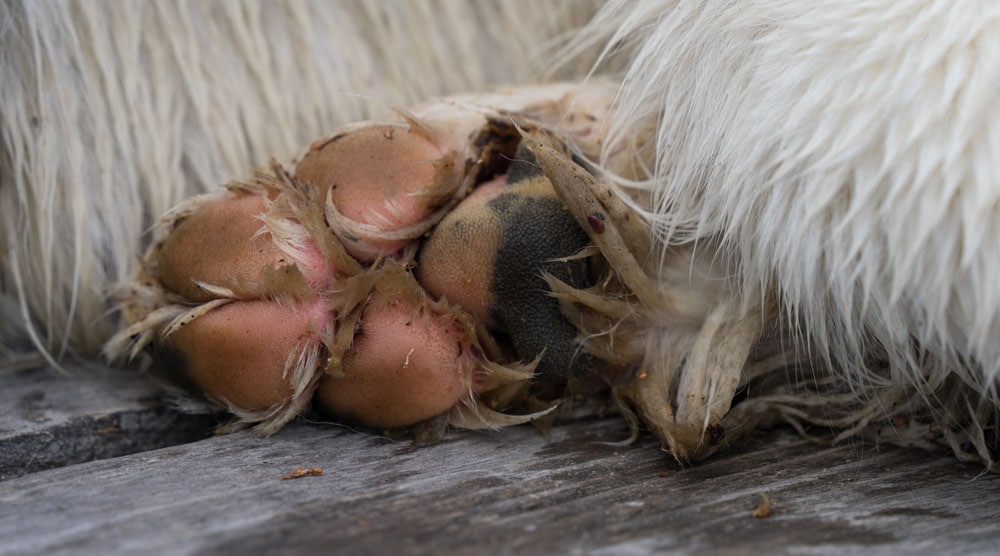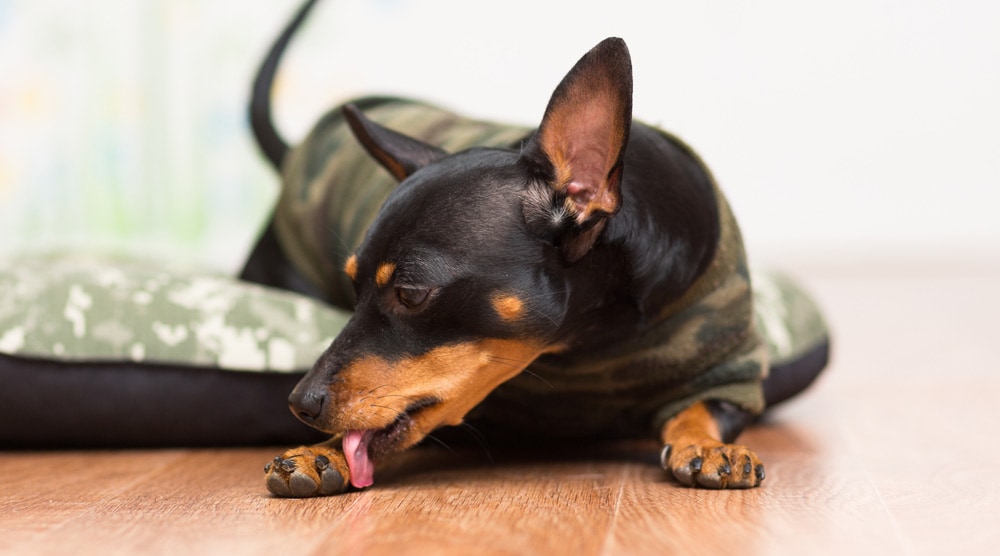If you’ve noticed a white bump on your dog’s paws, you’re probably wondering what’s causing it – and for good reason. Bumps and lumps anywhere on your dog’s body shouldn’t be ignored.
Some causes of white bumps are relatively mild, such as dry skin or a painless wart. However, white bumps can also be a symptom of conditions requiring veterinary care, such as bacterial infections or cancer.
In this article, we’ll discuss the main causes of white spots on a dog’s paw. We’ll also talk about when you should visit a vet and potential treatments.
Contents
8 Causes of White Bumps on a Dog’s Paws
Bacterial Skin Infections (Pyoderma)
Bacterial skin infections (also known as pyoderma) are a common problem for dogs. A dog’s skin usually blocks bacteria from entering the body. However, a wound, infection, or other skin problem can allow bacteria to enter and cause an infection.
“I see this most often in my patients with atopic dermatitis, who tend to have itchy paws that they lick and chew,” says vet Dr Linda Simon.
Skin infections can take hold anywhere on the body, including the paw pads, and may lead to white, pimple-like bumps. Other symptoms of a skin infection can include redness, itchiness, and inflammation, which may cause the dog to lick or bite the affected paws.
You should always contact a vet if you suspect your dog has a bacterial skin infection. Antibiotics are often required to resolve the problem, so it’s important not to delay seeking treatment.
Dry Skin
Just like humans, dogs can suffer from dry skin – including on the paw pads. Dry skin is most common during colder months or in dry climates, but it can also be caused by environmental allergies.
Dry paw patches may appear as flaky white spots or bumps, especially if your dog has been licking the area.
In many cases, topical balms can be used to moisturise the paws and solve the problem. A supplement containing fatty acids and vitamin E may also help. Ongoing dryness should be assessed by a vet though.
Cysts or Warts
Warts are fleshy lumps that typically appear on either the paws or around the dog’s mouth. They are caused by the papillomavirus that often spreads among puppies.
While warts can be white, it’s more common for warts to have a pinky hue. Fortunately, warts are often harmless and resolve in a few months, but they should still be checked by a vet to rule out other types of lump.
Cysts, which appear as small bumps, are potentially more problematic than warts. They can cause pain and discomfort, depending on the location. In some cases, cysts can also become infected and even rupture. For these reasons, cysts should always be checked by a vet.
Rock Salt Exposure
During winter, rock salt that’s spread on pavements can irritate your dog’s paw pads. The result is often small white blisters or bumps, although in some cases rock salt can cause pink paws or red paw pads.
To prevent this issue, it’s a good idea for your dog to wear boots when walking in the winter. You should also always rinse your dog’s feet after walks to remove rock salt and other potentially harmful chemicals.
Ticks
Ticks can sometimes appear as small white lumps if they’ve been feeding for a while. These parasites can attach themselves anywhere on a dog’s body, including between the paw pads.
However, it’s important to be sure that the lump is actually a tick before you try to remove it. The tell-tale sign is black legs that are close to the skin. Use a twisting motion to remove the tick and ensure the mouth isn’t left in the skin.
“Owners I see often worry a lump is a tick, even when it has been present for weeks or months,” says Dr Linda Simon. “Ticks usually fall off after about 4-5 days of feeding, so any lump present for more than this time is not likely to be a tick.”
Tip: If you’re unsure how to remove a tick, it’s best to take your pet to a vet. They will be able to remove it safely and without leaving the mouth in place.
Paw Pad Keratomas (Corns)
Keratomas are growths on the paw pads. They are caused by an overproduction of keratin-producing cells, and can be very uncomfortable for a dog to stand on.
There are several theories about what causes corns. These include an infection, scarring, and repetitive pressure on a certain area of the footpad. Walking on rough surfaces may also make corns more likely.
“In practice, it is nearly always sighthounds like the Greyhound that I see with corns,” says vet Dr Linda Simon. “They are notoriously tricky to eradicate and can cause quite a lot of discomfort for the patient.”
You should discuss any potential corn on your dog’s paw pads with a vet. The corn may need to be surgically removed, depending on how much discomfort it’s causing your dog.
Vitiligo (White Spots)
Vitiligo is a condition that causes patches of skin or hair to lose pigment. This results in white spots that typically occur on the face, but can also happen on the paw pads or the rest of the body.
The good news is that vitiligo typically isn’t dangerous or contagious. It’s also a rare condition. However, you should discuss any changes to your dog’s skin with your vet just to be sure.
Cancer
One of the reasons a vet should check any new paw lump is that it could be a cancerous growth. While this is less likely than some other options on this list, the possibility of cancer shouldn’t be ignored.
Some types of cancer that are more common on the paws include mast cell tumours, melanomas, carcinomas, and sarcomas.
Related Article: What Are Black Spots on My Dog’s Paws?
When Should You Visit a Vet About White Lumps?
White lumps on the paws – or any lumps on your dog’s body for that matter – should always be checked by a vet. It’s important to rule out the most serious conditions, such as infections and tumours.
You should also watch for changes to the lumps on your dog’s paws. If a lump grows, changes shape, becomes ulcerated, or causes pain or discomfort, it’s time to seek urgent veterinary advice. Remember, early detection and diagnosis can be critical.
Similarly, you should visit a vet if you notice any other symptoms of illness or behavioural changes.
Your vet may need to use a variety of diagnostic techniques to accurately diagnose the white lump. While a visual inspection and case history might be enough in some cases, they may also need to use fine needle aspiration, X-rays, or a biopsy.
Summary
White lump on a dog’s paws can have a variety of causes. These can include skin infections, ticks, cysts, warts, and cancerous tumours.
It’s important to visit your vet to get an accurate diagnosis of any white bump or lump on your dog’s paws. The first step is to rule out the most serious conditions. Then, once the lump is diagnosed, your vet can recommend an effective treatment.
Do you have any questions about white bumps on a dog’s paws? Please let us know in the comments section.




